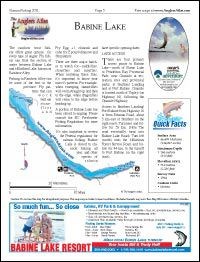Babine Lake is home to a special strain of rainbow trout that grow much larger than common rainbow trout species. This strain of trout is part of a rare ecotype called the Sutherland population.
These rainbow trout feed on forage fish, likely kokanee, and grow quite large. This group of fish are technically referred to as "pelagic piscivorous rainbow trout ecotype" --which basically describes where the fish live (pelagic means open water)and what they feed on (piscivorous means they feed on fish).
There is limited information regarding the size of Babine Lake's Sutherland population, and because it is a rare ecotype, anglers are encouraged to practise catch-and-release when going after these big rainbow trout, to encourage the long term sustainability of this species. Barbless hooks are also encouraged to improve survivability.
Fisheries biologist in Smithers, Joe DeGrisi, says that the ministry has begun a research program on Babine Lake to determine if the stock is sustainable at present levels. They will be looking at the habitat and conducting surveys on tributaries as well.
Babine Lake is known for producing trophy char, rainbow trout and salmon.
Some productive lures for this lake are Rapalas, Apex, Williams Wablers and Flatfish for the char. For trout, use small spinners and spoons, flatfish and Hotshots.
Early in the season the char will inhabit shallow waters, but as the water warms up the fish migrate to deeper, cooler sections of the lake.
The rainbow trout fishery offers great options for every type of angler. Fly fishers can float the section of water between Babine Lake and Nilkitkwa Lake, known as Rainbow Alley.
Fishing in Rainbow Alley can be some of the best in the province. Fly patterns that can work well are stoneflies and Fry Egg +1, chinook and coho fry, Epoxy Minnows and Stimulators.
There are three major hatches to watch for--caddisflies, stoneflies and mayflies. When imitating these flies, it's important to know your insect's patterns. For example, when emerging, damselflies will swim straight up and then to the edge, while dragonflies will swim to the edge before heading up.
A portion of Babine Lake has been closed to angling. Please consult the BC Freshwater Fishing Regulations for more information.
It's also important to review the Federal regulations for salmon fishing. Babine Lake is closed to chinook fishing all year, and other species of salmon have specific opening dates.
LAKE ACCESS
There are four primary access points to Babine Lake--north of Burns Lake to Pendelton Bay Provincial Park; near Granisle at recreation sites and provincial parks; at Smithers Landing and at Fort Babine. Granisle is located north of Topley (on Highway 16), following the Granisle Highway.
Access to Smithers Landing/Fort Babine from Highway 16 is from Eckman Road, about 5 km east of Smithers on the right (east). Turn here and follow for 53 km. (Note:The road eventually turns into Babine Lake Road). Turn left (north) onto the Nilkitkwa Forest Service Road, and follow for 44 km, to the turnoff to Fort Babine on the right (east).
Download Map: http://www.mapjungle.com/geoproduct/download/1465100?widgetID=18
Find and download hundreds of fishing maps from BC on The Citizen's fishing page.
http://www.princegeorgecitizen.com/section/princegeorge02&template=fishing_maps
Copyright 2011 by The Angler's Atlas


